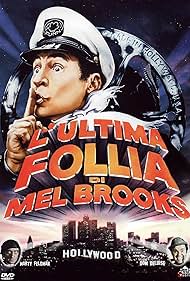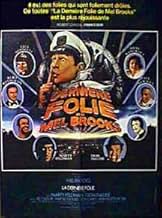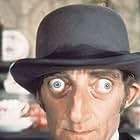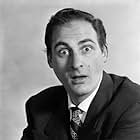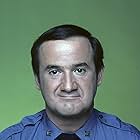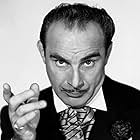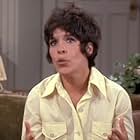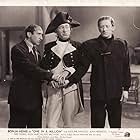VALUTAZIONE IMDb
6,7/10
18.801
LA TUA VALUTAZIONE
Un regista e i suoi strani amici lottano per produrre il primo grande lungometraggio muto in quarant'anni.Un regista e i suoi strani amici lottano per produrre il primo grande lungometraggio muto in quarant'anni.Un regista e i suoi strani amici lottano per produrre il primo grande lungometraggio muto in quarant'anni.
- Premi
- 1 vittoria e 6 candidature
Trama
Lo sapevi?
- QuizOn the May 19, 1981, broadcast of The Tonight Show Starring Johnny Carson (1962), Alan Alda related his experience of attending the film's 1976 premiere in Westwood (which had Mel Brooks and Anne Bancroft in the audience). Alda said he probably laughed harder than anyone in the crowd, and once the movie had ended, he approached Brooks and Bancroft to compliment them on a job well done. According to Alda, Bancroft didn't miss a beat and responded, "Oh, that was you laughing? You see, Mel? I told you SOME idiot would find this funny!"
- BlooperNearly every dialog card has a punctuation mistake.
- Citazioni
Mel Funn: [seen as an insert title] Mr. Marceau, how would you like to appear in the first silent movie made in nearly fifty years?
Marcel Marceau: [in French, the only spoken line in the film] Non!
Dom Bell: [seen as an insert title after Mel hangs up the phone] What did he say?
Mel Funn: [seen as an insert title] I don't know. I don't speak French!
- Curiosità sui creditiAt the end of the movie, the letter O of the ending word ''GOOD BYE'' is zooming out, just like at the beginning with the word ''HELLO''.
- Versioni alternativeOn television prints, some of the subtitles are remade to become less offensive.
- ConnessioniFeatured in Sneak Previews: The Top Ten Films of 1976 (1977)
- Colonne sonoreI Left My Heart In San Fransisco
(uncredited)
Written by George Cory (as Cory George C. Jr.) and Douglass Cross (as Cross Douglass)
Recensione in evidenza
Mel Brooks plays a has-been director named Mel Funn in this spoof of Hollywood and silent movies. The film is set in some alternate universe era that is an amalgamation of 1930s through 1970s Hollywood. In the film's world, it's the age of the "talkies", which have apparently been around for some time. Funn's latest script, what he's banking on as his comeback, is retro--he's written a silent movie. Naturally, he's having problems selling his script. Shortly after the film begins, Funn, who is making the rounds with his two questionable companions, Marty Eggs (Marty Feldman) and Dom Bell (Dom DeLuise), shops his script to one last big studio head, played by Sid Caesar. Caesar's studio is about to go under if they can't produce a blockbuster. He initially tries to throw Funn out, but when Funn promises he can get big stars for his film, Caesar gives him a chance. If he can get the stars, he's got a deal. Silent Movie is primarily the story of Funn, Eggs and Bell trying to get stars to do their film.
Of course the irony of Silent Movie is that it's a silent movie about how silent movies would be ridiculous to produce in a later age in Hollywood. The Mel Brooks film itself is ridiculous film in many ways, not the least of which is that it is silent. Brooks also embraces another fading convention--humor based on slapstick and vaudeville.
To a large extent, Silent Movie exists to enable a series of gags, mostly centered on various extended cameos. Often the gags are like a classic comedy compilation--we get Sid Caesar doing his "facial tick schtick", Charlie Callas doing some "blind man" slapstick, Henny Youngman with a fly in his soup, and so on. Marty Feldman's "Eggs" might cause us to ask where the ham is--these classic routines are it.
There are also longer scenes with potential "stars" of the film. These include Burt Reynolds, James Caan, Bernadette Peters, Liza Minelli, Paul Newman, Anne Bancroft, and Marcel Marceau. Sometimes they spoof themselves, sometimes they play roles in new gags, and sometimes they come pretty close to their actual public personae.
Maybe Twentieth Century Fox told Brooks in reality that if he wanted to do a silent film spoof, they'd only bankroll it if he had a lot of stars attached. So he got them, working them into the film without really working them into the fabric of the film (they're present as cameos, not as stars). But there's also a conceit in Silent Movie, as a fiction, that we're not watching the actual film but a film about getting ready to make a film, maybe echoing what happened in "real life" in preparing to make the film. If you want complex self-referential layers, focused on blurring the distinctions between art and reality, Silent Movie definitely provides that. In many respects, the layering is similar to the more recent Incident at Loch Ness (2004).
Maybe such depth is surprising given that the surface aim of Silent Movie is to provide absurdities so you can laugh. The contrast to those easier to decipher surface qualities underscores interesting facts both about the public perception of Mel Brooks and the history of his career. Brooks has often been perceived as aiming for a kind of modernization of the Three Stooges. While his films have qualities that allow for that comparison, it is far from telling the whole story.
Brooks' films (as director) at least through 1981's History of the World, Part I all have a strong postmodernism beneath the veneer. He's not just making us laugh through slapstick and clever, pun-filled dialogue, he's also saying a lot of very intelligent things about the medium of film, as well as the relationship between films and reality, and between films and the audience. A lot of his humor rests on toying with the typical filmic or narrative conventions. For example, he routinely breaks through the "fourth wall" and he routinely breaks the implicit genre contracts he makes. It's just as intellectual as anything Monty Python did--at least until 1987's Spaceballs, which can be seen as the turning point from Brooks' earlier works of genius to a much more straightforward way of storytelling. It's not that Spaceballs and what followed weren't good, but they do not have the same sense of postmodernist play to them as is present in Silent Movie.
In addition to all of the fiction/reality layering, the film breaks the "genre" contracts of silent films in that once in awhile a character says something and we hear their voice on the soundtrack. The music is also frequently synced to the action (this wasn't possible with actual silent films--the technical "solution" that allowed synced music also allowed synced dialogue), and occasionally there is foley (sound effects that are supposed to be the sound of character actions, like walking) synced on the audio track as well. It underscores that this is a faux silent movie, despite the many other apparent cues of authenticity. This is a relatively minor example of postmodernism in the film, perhaps, but nevertheless illustrative of Brooks' goals and interesting to note while watching.
As interesting as all of that is, Silent Movie isn't a complete success. Sometimes it's just a bit too hokey or uneventful for its own good. But it's still an important entry in Brooks' early oeuvre, which is his most significant period in my view.
Of course the irony of Silent Movie is that it's a silent movie about how silent movies would be ridiculous to produce in a later age in Hollywood. The Mel Brooks film itself is ridiculous film in many ways, not the least of which is that it is silent. Brooks also embraces another fading convention--humor based on slapstick and vaudeville.
To a large extent, Silent Movie exists to enable a series of gags, mostly centered on various extended cameos. Often the gags are like a classic comedy compilation--we get Sid Caesar doing his "facial tick schtick", Charlie Callas doing some "blind man" slapstick, Henny Youngman with a fly in his soup, and so on. Marty Feldman's "Eggs" might cause us to ask where the ham is--these classic routines are it.
There are also longer scenes with potential "stars" of the film. These include Burt Reynolds, James Caan, Bernadette Peters, Liza Minelli, Paul Newman, Anne Bancroft, and Marcel Marceau. Sometimes they spoof themselves, sometimes they play roles in new gags, and sometimes they come pretty close to their actual public personae.
Maybe Twentieth Century Fox told Brooks in reality that if he wanted to do a silent film spoof, they'd only bankroll it if he had a lot of stars attached. So he got them, working them into the film without really working them into the fabric of the film (they're present as cameos, not as stars). But there's also a conceit in Silent Movie, as a fiction, that we're not watching the actual film but a film about getting ready to make a film, maybe echoing what happened in "real life" in preparing to make the film. If you want complex self-referential layers, focused on blurring the distinctions between art and reality, Silent Movie definitely provides that. In many respects, the layering is similar to the more recent Incident at Loch Ness (2004).
Maybe such depth is surprising given that the surface aim of Silent Movie is to provide absurdities so you can laugh. The contrast to those easier to decipher surface qualities underscores interesting facts both about the public perception of Mel Brooks and the history of his career. Brooks has often been perceived as aiming for a kind of modernization of the Three Stooges. While his films have qualities that allow for that comparison, it is far from telling the whole story.
Brooks' films (as director) at least through 1981's History of the World, Part I all have a strong postmodernism beneath the veneer. He's not just making us laugh through slapstick and clever, pun-filled dialogue, he's also saying a lot of very intelligent things about the medium of film, as well as the relationship between films and reality, and between films and the audience. A lot of his humor rests on toying with the typical filmic or narrative conventions. For example, he routinely breaks through the "fourth wall" and he routinely breaks the implicit genre contracts he makes. It's just as intellectual as anything Monty Python did--at least until 1987's Spaceballs, which can be seen as the turning point from Brooks' earlier works of genius to a much more straightforward way of storytelling. It's not that Spaceballs and what followed weren't good, but they do not have the same sense of postmodernist play to them as is present in Silent Movie.
In addition to all of the fiction/reality layering, the film breaks the "genre" contracts of silent films in that once in awhile a character says something and we hear their voice on the soundtrack. The music is also frequently synced to the action (this wasn't possible with actual silent films--the technical "solution" that allowed synced music also allowed synced dialogue), and occasionally there is foley (sound effects that are supposed to be the sound of character actions, like walking) synced on the audio track as well. It underscores that this is a faux silent movie, despite the many other apparent cues of authenticity. This is a relatively minor example of postmodernism in the film, perhaps, but nevertheless illustrative of Brooks' goals and interesting to note while watching.
As interesting as all of that is, Silent Movie isn't a complete success. Sometimes it's just a bit too hokey or uneventful for its own good. But it's still an important entry in Brooks' early oeuvre, which is his most significant period in my view.
- BrandtSponseller
- 28 mar 2005
- Permalink
I più visti
Accedi per valutare e creare un elenco di titoli salvati per ottenere consigli personalizzati
- How long is Silent Movie?Powered by Alexa
Dettagli
Botteghino
- Budget
- 4.400.000 USD (previsto)
- Lordo Stati Uniti e Canada
- 36.145.695 USD
- Lordo in tutto il mondo
- 36.145.695 USD
- Tempo di esecuzione1 ora 27 minuti
- Colore
- Proporzioni
- 1.85 : 1
Contribuisci a questa pagina
Suggerisci una modifica o aggiungi i contenuti mancanti

Divario superiore
By what name was L'ultima follia di Mel Brooks (1976) officially released in India in English?
Rispondi